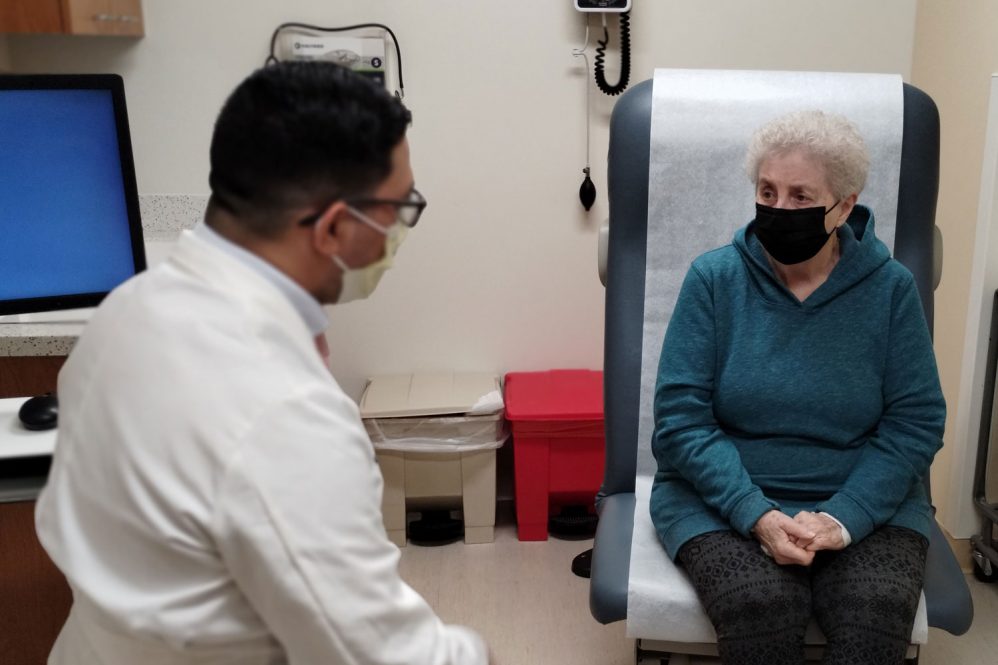Not many people can say they’ve survived two brain aneurysms.
Aneurysms often are silent killers — largely undetectable until they rupture and cause a dire emergency.
That’s what happened to Edith Heeber in July 2021. She suffered a hemorrhagic stroke caused by a dissecting brain aneurysm. Except the care she received at UConn Health saved her life.
It turns out, it most likely saved her life twice.
I really want to thank all the nurses and doctors and staff at UConn for their wonderful care. — Edith Heeber
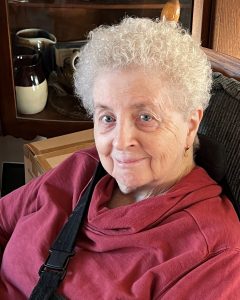
Heeber, of Enfield, would spend most summer weekends camping with her daughter, Taryn Heeber-Doody, in the woods of Granville, Massachusetts. The weekend of July 10, 2021, was different.
“She’s my camping buddy, she even used to stack wood,” Heeber-Doody says. “She was supposed to go to the camp with me, but she stayed home because she wasn’t feeling that great, a little tired.”
But there was no indication her mother, 79 at the time, was on the path to a life-threatening brain hemorrhage the next day. Her son, Billy, found her in distress in her home early that Sunday morning.
“I just remember telling Billy to call 911, and I remember an ambulance coming, I remember a partial ride,” Heeber says. “They evidently took me to St. Francis. I don’t remember them transferring me here.”
The transfer came in recognition of UConn Health’s ability to handle cases of this magnitude, led by Dr. Ketan Bulsara, chief neurosurgeon. Bulsara is internationally recognized as a pioneer in complex procedures, dually trained in skull base cerebrovascular microsurgery and endovascular neurosurgery.
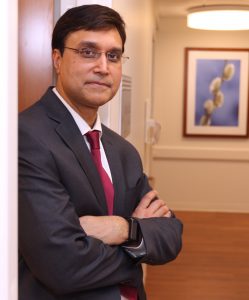
“With this condition there’s about an 80% risk of morbidity and mortality,” Bulsara says. “About 30% to 40% never make it to the hospital, the rest are left with potentially devastating consequences.”
Dr. Abner Gershon, an interventional neuroradiologist, diagnosed Heeber with a dissecting aneurysm of her vertebrobasilar system based on initial imaging. Bulsara confirmed this with a cerebral angiography. He reconstructed the vertebrobasilar system using stents and eliminated the aneurysm.
“I walked in the room and I remember not knowing what to expect, and I remember stopping in my tracks,” Heeber-Doody says. “It was just a shock. It was like, ‘O my God’ scary… she had a breathing tube down, she was completely out of it, all these machines and everything.”
She still has a photo from that moment, which she showed her mother while recounting the story.
“Yeah, that would stop me in my tracks too,” Heeber reacted. “That isn’t me.”
Heeber-Doody would spend every day visiting her mother in the hospital.
“Just a lot of praying and a lot of talking to her just saying, ‘Come on, you can’t leave me, you’re my best friend. Come on. Holy God.”
Unable to have any dialog with her mother, Heeber-Doody started writing to her in a journal in hopes she eventually would wake up and be able to read it.
Over the course of the next two weeks, she did wake up.
“I don’t remember any of it,” Heeber says of her hospital stay. “I don’t remember anybody coming to visit me. Although, according to the book, a lot of people came to visit. I don’t remember waking up here at UConn. I remember being at Mount Sinai, but I don’t know how long I was here before I went there.”
The Mount Sinai Rehabilitation Hospital is where she went after a two-and-a-half-week stay at John Dempsey Hospital. Heeber-Doody remembers much more, including how happy she was with her mother’s care at UConn Health.
“We were very impressed with this hospital and all the nurses and all the staff,” Heeber-Doody says. “They were wonderful, absolutely wonderful. She had mentioned it’s too bad it’s so far [from home in Enfield], and I said, ‘It doesn’t even matter because we’ll come here for whatever you need with your brain.’”
Heeber-Doody says one of the physicians who spent a lot of time with her mother was Dr. Gracia Mui, a neurologist with co-director roles in UConn Health’s stroke program and intensive care unit.
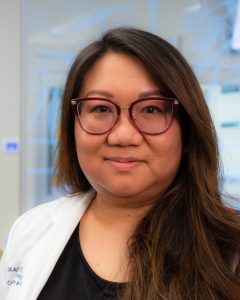
“It really takes a multi-disciplinary team to take care of patients with aneurysmal intracranial hemorrhages,” Mui says. “Healing from this disease can be a long, arduous road with many medical complications. Along with the neurosurgery team, our neurocritical care unit with neuro-intensivists, advanced practice providers, and phenomenal nurses can give these patients specialized care for the best chance at recovery.”
After less than a month of inpatient physical, speech and occupational therapy, Heeber was working with visiting nurses and physical therapists at home. Heeber-Doody moved back in to the house to help.
“At the time of her initial follow-up visit at three months, she had made an excellent recovery,” Bulsara says.
But now she would go on a watch list, of sorts.
“Patients who develop a spontaneous dissecting intracranial aneurysm are at high risk for developing new aneurysms of a similar etiology,” Bulsara says. “Therefore, she was closely monitored with surveillance imaging.”
Surveillance imaging includes a brain MRI and an angiogram, which allows physicians to visualize the blood vessels by injecting dye directly into them.
And that is how her emergency care at UConn Health likely saved her life twice.
More than a year after her July 2021 episode, a follow-up surveillance imaging appointment revealed something suspicious.
“Dr. [Leo] Wolansky [chief of radiology] noted the appearance of a new, very large middle cerebral artery perforator aneurysm on surveillance imaging,” Bulsara says.
To prevent a catastrophic brain bleed from this new aneurysm in a completely different location, urgent treatment was needed. It was two days before Thanksgiving. The intervention was an endovascular treatment where the surgeon accesses the femoral artery in the leg through a small puncture in the artery and navigates a small catheter to the brain and places coils to close the vessel feeding the aneurysm.
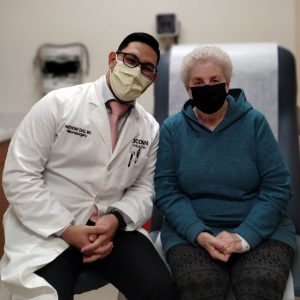
“The coils stop blood flow into the aneurysm and by doing so prevents it from rupturing. It also gives the vessel a chance to heal,” says Dr. Anthony Diaz, a neurosurgery resident who trains under Bulsara and who was part of that case.
If the second aneurysm went undetected and ruptured, “It probably would have lead to a devastating brain hemorrhage,” Diaz says.
A follow-up angiography showed the treatment was successful. She was discharged the day after the procedure and was home for Thanksgiving.
Both of Heeber’s procedures took place in the UConn John Dempsey Hospital’s hybrid operating room, which is equipped to handle a wide range of complex procedures.
Today, Heeber is back to living independently in her own home, with Heeber-Doody back in her own home, but both she and her brother are both nearby. Other than a walker to assist with balance, there are few visible signs of functional or cognitive deficits.
And she just celebrated her 81st birthday Jan. 23.
“I really want to thank all the nurses and doctors and staff at UConn for their wonderful care,” Heeber says.
“I’m amazed, I’m truly amazed,” Heeber-Doody says of her mother’s journey.
Learn more about the UConn Health Division of Neurosurgery and the UConn Health Stroke Center.
